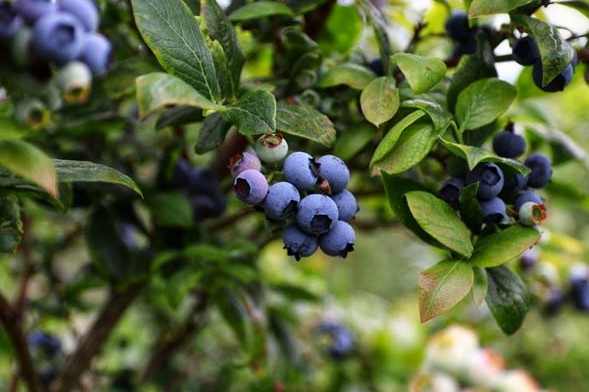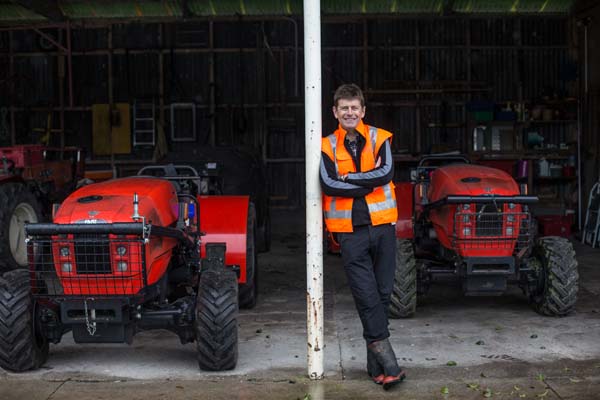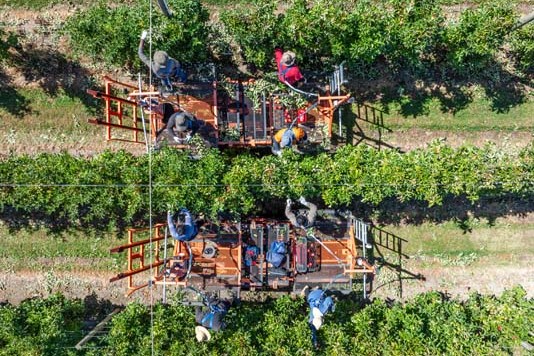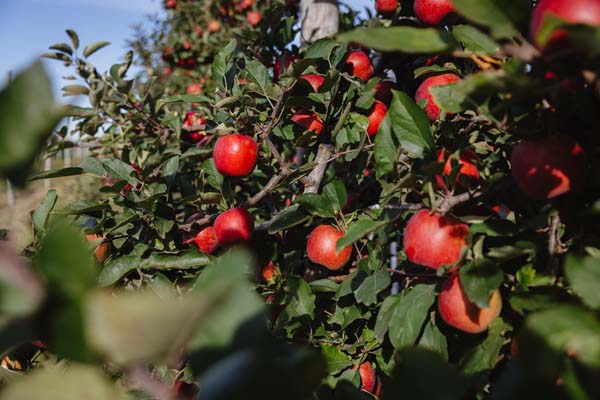Saving labour and better pasture utilisation are among the considerable benefits of cow collars. Anne Lee writes.
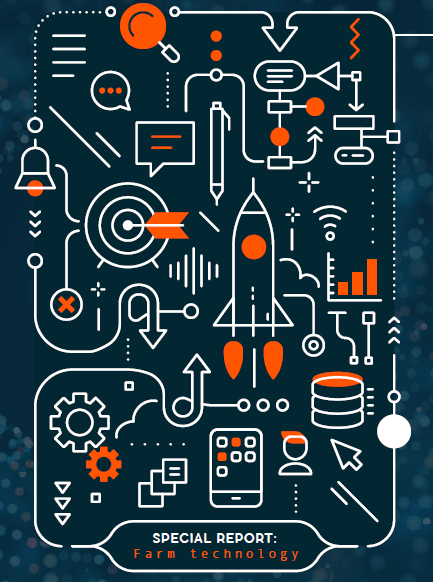 A few months after Emlyn and Hilary Francis put Halter collars on their 1500 dairy cows, they had a call from Catalyst Fuel Refunds asking what was up.
A few months after Emlyn and Hilary Francis put Halter collars on their 1500 dairy cows, they had a call from Catalyst Fuel Refunds asking what was up.
The company secures a refund for fuel excise taxes paid on the fuel used on off-road operations such as farms.
“Our fuel consumption had dropped so much, they called us.
“Our guys weren’t out there any more putting up fences, getting cows in twice a day, shifting breaks.
“Two days was all it took (to train the cows) and that was it – we haven’t put up break fences since,” Emlyn says.
The fuel saving is just one of the smaller but not inconsequential tangible benefits Emlyn and Hilary have found after installing the new technology.
The initial reason for investing was labour, the couple say, and it’s there and in pasture utilisation that they’ve really seen some big wins.
“The biggest bus rolling down the road at us is labour and the challenges around getting it.
“So having something that means our people are more engaged and having the ability to employ fewer people and cut hours worked all while enabling them to do a better job – it looked like a good option and that’s definitely how it’s turning out,” Emlyn says.
The Halter technology is the first cow collar technology to allow farmers to create virtual fences.
Cows receive sound and vibration cues from the GPS-linked and solar-powered collars.
Sounds signal to the cow that she’s approaching or crossed over a virtual fence with the sound growing more intense as she moves close to or over it while vibration indicates she is heading in the right direction.
While she’s inside the break and away from the fence she gets no cues.
If she goes beyond the boundaries and doesn’t come back to the right side of the break she receives a low-energy pulse. Sounds and vibrations are also used to move cows back to the farm dairy or on to another break.
Sounds coming from the right side of the collar direct the cow to move left and vice versa.
“It’s incredible how quickly they learn.
“We put the collars on in early June and on day two we drove a silage wagon through the virtual break for our winter milkers and fed out ahead of them.
“The cows moved towards the silage and then every one
of them stopped at the virtual line and not one cow came across.”
The Francis’ Kenmare farm near Culverden in North Canterbury is 630 hectares with a 440ha milking platform.
They peak-milk 1485 cows with about 200 milked through the winter. The farm is run by manager Iegor Kudinov with the help of five full time staff and a maintenance manager who works across both Kenmare and the Francis’ second farm, the 210ha Upper Balmoral which has 640 cows and is managed by contract milkers – it doesn’t have collars. Another early test for Halter, soon after the collars were installed on Kenmare, was managing cows on winter crops grown on the support area.
“For the first time ever we had no one cutting breaks in the kale to put up the fences and no fences, it was quite incredible to see really,” Emlyn says.
“If it got wet in an area of the paddock or it rained we could fence off an area or even move the cows off the crop, all while sitting inside – no getting out there in the cold and wet.
“We definitely managed the wintering better – less soil damage and pugging,” Iegor says.
Having the ability to put the fence anywhere means you can draw an alleyway back to a trough while back-fencing cows to keep them out of most of a previously grazed area.
If need be that alleyway could be changed every day or after a few hours.
“It takes 30 seconds to draw up a break on the app on your phone – you can do it from anywhere and you can set them up in advance so they are pre-programmed,” Iegor says.
“I trust it can do the job so well that this year we’re going to give it a crack on the fodder beet we have on the milking platform for autumn feed,” Emlyn says.
Over spring it made a significant impact on pasture utilisation and cow intakes thanks to the incorporation of the pasture planner in the app. “You can set the break and the app tells you what’s available so you can be very accurate with where you place the fence to make sure cows are getting what you’re wanting to feed them.
“And you can run as many mobs as you want to because it’s so easy and quick,” Iegor says.
“In theory you could be as accurate with reels and standards and you could be moving cows all the time but in reality, that’s never going to happen – people don’t have time and let’s face it they’re not going to want to,” Emlyn says.
Iegor and Emlyn say the farm has grown more grass thanks to better pasture management and utilisation was better, so much so that they’re 7% up on production with 100 fewer cows and they’ve reduced the amount of bought-in supplement.
“We’ve cut our grain by 100 tonnes,” Iegor says.
THE PEOPLE FACTOR
Over spring they were able to operate comfortably without anyone extra over calving but importantly everyone’s hours were down.
“People were working 45 hours a week over calving on a six on two off roster and when we average the hours out over the season, we think they’re going to be way down on what they’ve been in the past,” Hilary says.
Through the rest of the season staff work 8 on 2 off then 8 on 3 off.
“You can really see how engaged they all are,” she says.
“The people side of this is huge – they’re always on their phones anyway – this way they can be on their phone and move the cows, set up the break fence or bring the cows in for milking,” Emlyn laughs.
Those on the first herd at morning milking get an extra hour to
sleep in because no one has to get the cows in. “They’re there at the shed when the guys turn up.”
No one has to go and shut them in their paddock because the virtual fence will do that and everyone can see, at a glance on the app, that every cow is where they’re supposed to be.
Iegor says the time saved allows other jobs to get done properly but it doesn’t mean any less attention is paid to monitoring cows on their break and observing how they’re going with getting through their allocation.
“We go out and check on them mid-morning and if we need to shift the break – give them more or less – it takes 30 seconds to do it.”
Pasture covers are assessed weekly with the information loaded into the app. Round length, average pasture cover and growth rates are calculated and a feed wedge produced. Even if a paddock has previously been grazed with several breaks in it and it’s then fed as a combination of those breaks in the next grazing round, Halter’s algorithms calculate each area to give the total average amount of drymatter available.
As soon as cows move out of a break and are back-fenced so they can’t return then the pasture planner programme resets that area back to day zero, giving accurate data inputs for the next grazing cover calculation.
EVOLVING THE BUSINESS WITH VIRTUAL FENCING
South Waikato dairy farmer Pete Morgan joined Emlyn and Iegor in January at Kenmare for a field day to share information and give farmers a chance to question them about how they use the technology. Pete and his wife Ann were early adopters of the collars, giving feedback that’s helped in the development of the technology.
They bought their farm in 2000 and have grown it from 110ha to 240ha and milk 630 cows. Over the years they have gone from system two to system three and back down to system two again with little bought-in feed.
“Our business is still evolving and Halter has played a role in that,” he says.
Staff hours have dropped from 58 to 44 hours a week and the nature of the work has changed dramatically. He has three full-time staff and says the conversations are now much more focused on pasture management. Two of his team only have a year’s experience and they are already allocating pasture, setting breaks in the app.
“We’ve been able to fast track that learning because there’s time for those discussions.
“When they’re out on the farm more time is spent measuring pasture, making sure the allocations are right and making judgement calls on residuals.
“In the past they would have just been told where to put up the break and they’d go through the motions of rolling out the reel and putting in the standards, not really learning anything about feeding cows for what could be years.
“We talk about management things now, not just operational,” Pete says.
“What we’re trying to do is develop people who will go on to one day buy our farms,” Emlyn says.
He plans to use Halter as a drawcard in his next recruitment round this year. The collars measure rumination and activity too and using all of the data the so dubbed and trademarked “Cowgorithm” will create health and reproductive heat alerts. As of December
that information now connects directly with Minda so for those with Protrack like Emlyn and Hilary, cows can be automatically drafted out.
For those with manual drafting, like Pete and Ann the flashing light on collars on cows with alerts makes it easier to find them.
“The collars are using a range of information to make the decisions on those alerts – for heats for example, if you’re using tailpaint – that’s one measure – has she been rubbed.
“With the collars they’re picking up rumination – so they’re seeing a decline in eating, walking activity, which cows they’re hanging around with.
“Then all that data is being analysed and in what’s virtually real time the technology is very accurately picking up those cows,” Pete says.
They had always had good reproductive performance and using Halter has ensured that’s continued.
“What we’ve probably been able to do more of is find those heats that might not have been picked up just by tail paint and we’ve been able to look at the data to help make decisions on anoestrus cows and intervention.
“We’ll pull out small numbers of cows, looking at those that haven’t returned 35 days after mating and PD (pregnancy diagnose/test) them and we do find the odd one or two that’s become anoestrus.
“So we have four waves of small numbers of CIDRs and that lets us catch – especially those high producing younger cows, giving them another shot at getting in-calf right up to the end of mating.”
Both Peter and Emlyn say the health alerts for individual cows are enabling them to act early and draft those cows out for closer inspection.
“If there’s not something obvious we’ll do the usual diagnostic things – take their temperature, check gums, teeth, vulva for Theileria, lameness, we’ll RMT (rapid mastitis test) the milk but on occasion there’s nothing obvious.
“We’ve changed the name of our sick mob to the resting mob because given a couple of days of once-a-day (milking) and less walking some come right without ever presenting with a health problem.” Both would like to see the health and rumination data at a mob or herd level.
“I’d like to look at things like sorting up a herd on rumination data – so you could have all the cows with higher rumination – that are supposedly eating more, and theoretically producing more run together,” Emlyn says.
They’d also like to see more New Zealand research to back up the trigger levels on metrics such as rumination.
Both Pete and Emlyn say they can’t imagine farming without the technology now. Farmers lease the collars and pay an annual subscription that depends on the package they subscribe to and the number of cows.
The core package includes virtual fencing and movement of cows along with animal health alerts while the more-costly Pro package also includes heat detection, the pasture planner, nutrient loading maps and in-paddock drafting.
Emlyn puts the cost at close to 40c/kg MS/year.
“I think now we see what this can do and the potential for more developments and I wouldn’t be without it – I’d rather try and look for 40c/kg MS cost savings somewhere else than give it up now.
“That said you have to see tangible value created by it – it has to pay its way but for me the intangibles mean that as long as we think we’re breaking even on it I’d be happy,” Emlyn says.
Pete says he’s calculated that both the tangible and intangible benefits create about a 30% return on his investment. Both agree it is costly but say it’s game-changing technology.
Pete’s been providing key feedback for its development for the past two years and says he’ll continue to do that because he believes there’s more value yet to be gained as new uses and understanding develop.
The discussion among farmers at the field day also took on a brainstorming theme with future possibilities –
What if the algorithm and sensors could tell when the cow was urinating and get it to walk a few steps so nitrogen from the urine was more spread out?
What if it could detect cows burping so those that burped less could be identified or more accurate measures of methane could be produced?
The technology can already provide nutrient loading maps, showing where cows spend the most time. That’s enabling farmers to vary fertiliser applications and limit nitrogen applications, for instance, on those areas, making more of their 190kg N/ha limit available for the rest of the paddock.
For Pete and Ann the technology is driving them to fully reconsider how they farm. They’ve taken out 40% of their fences and the historic boundaries to where and how they graze are disappearing.
“What we have to think about now if we have this technology is how we actually want to run our farms because if anything is possible and we’re not bound by physical fences or time when it comes to where we put cows and how long they’re there what do we actually want to do?
“The information and data we have at our fingertips is growing.
“What’s going to be limiting for people now is their own level of motivation.”


